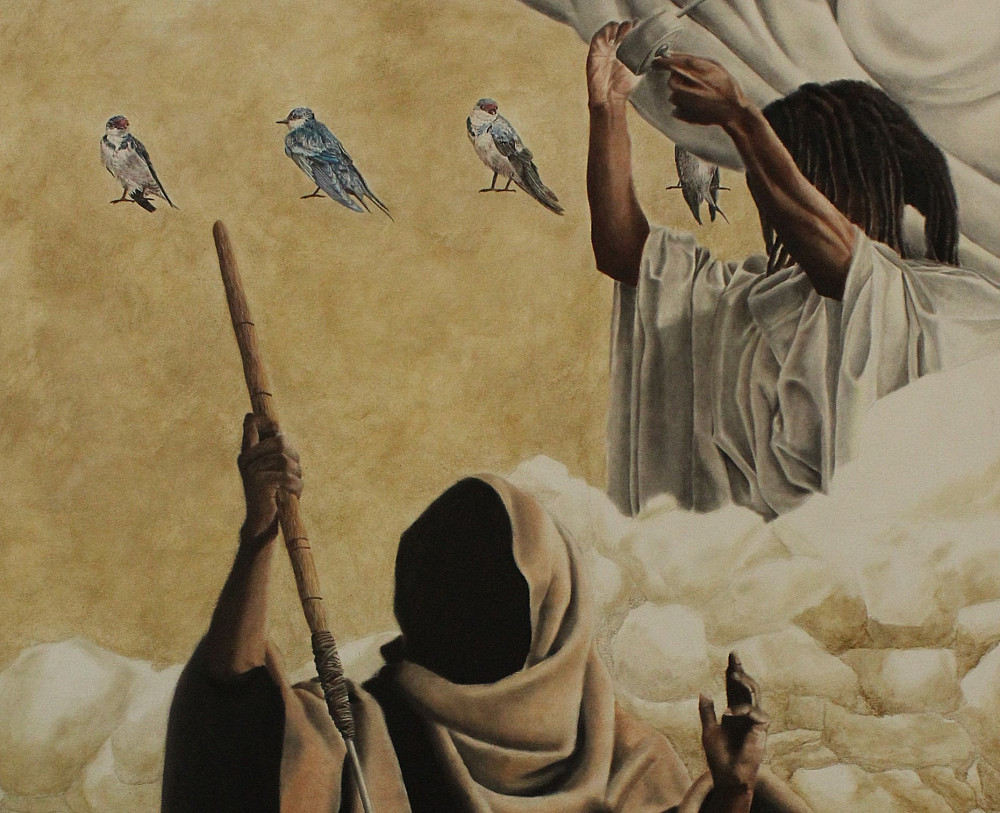
Published 12 November 2025 in Gallery Conversations
Interview by Petra Peppler
1. Your writing speaks of “socio-spiritual undeath” and ongoing metaphysical death — can you speak more about what healing looks like within that space, and whether healing is even the goal?
Afropessimist thought is hinged on the thought that there can be no healing for the black, for healing presumes an original state of fullness. To be black is to be born lacking, this work is my attempt not to heal, but to salve continuously. It is a sort of restructuring of the idea of healing as a process unto itself instead of the means to reaching a healed state. And for me right now that process is the making of the artwork, the meditation of process and the referencing of the mystic material practices of my people.
2. You describe the act of prayer as a kind of surrender and not fully knowing why you do it. How does this uncertainty shape your artistic process or influence the way you approach making and exhibiting work?
Prayer for me is a complex act because I’m not particularly religious, I don’t have a being to whom I’m praying necessarily. The act is itself an exercise in uncertainty, my prayer has no method, no receptive god, and perhaps no empirical purpose - at least not for certain. The uncertainty inherent to the process reflect in the work as the uncertain reference, the contradictory meaning, the in-explainable motif. The work is as steeped in uncertainty as the prayer that accompanies it. All of it is in some way about finding comfort in not knowing.
3 The work is deeply rooted in place — both your ancestral home in the Eastern Cape and Johannesburg’s Euro-centricity. How does your relationship to land, dislocation, and memory inform the materials or visual language of the exhibition?
Land and what it means for me personally, culturally and spiritually enters the body of work through the Amen pieces. Here aerial views of satellite maps of my home village of Macacuma become the reference points for the creation of imaginary maps made with the soil of Johannesburg. Meditations on nativity in foreign land which is also home, and the spiritual energies carried into those spaces by bodies of water like the Jukskei and Oranges Rivers. The land here, become the holder if death, the page upon which migration, exile, push and pull factors and geopolitics scribe a language of dying and living in continuous synchronicity in this and in other lives.
4 You mention this exhibition as a ‘second iteration’ of the first. How has your understanding of the work changed since the initial showing, and what new meditations emerged during this continuation?
Being offered the chance to show this work a second time has been harder than I thought it would be. The weighty emotions of the first, emotions with which i had at the time chosen to do nothing but sit with have come flooding back with gnarled teeth and ferocious potencies. This second iteration can be no more than another moment to sit with these thoughts in what they are now, after I have moved and attempted to reconvene with the human tendency to heal. It has proven difficult for me to sit silently but I am here sitting, engaging with what this ever-present little death has come to present itself as now in this new personal and exhibitory context. I think the more important question isn't what new meditations or thoughts have emerged since the first, but how I stand with those initial thoughts and feelings now, it is a moment to statically revise.
5 There’s a powerful tension between stillness and movement, death and hope, absence and presence throughout your writing. How do you hope viewers will engage with that tension
I've begun to try to let go as much as I can of any expectations i might have for what the viewers of my work could gleam from it. I think the beauty of the constructivist relationship between artist, artwork, and viewer is that it is three-way conversation between all members, never just the artist and the work, nor the work and the audience. The work floats, it mediates a conversation that enriches all involved including the work itself. My best and only hope is that the work allows rigorous exchange or motion or stimuli or consideration, etc.